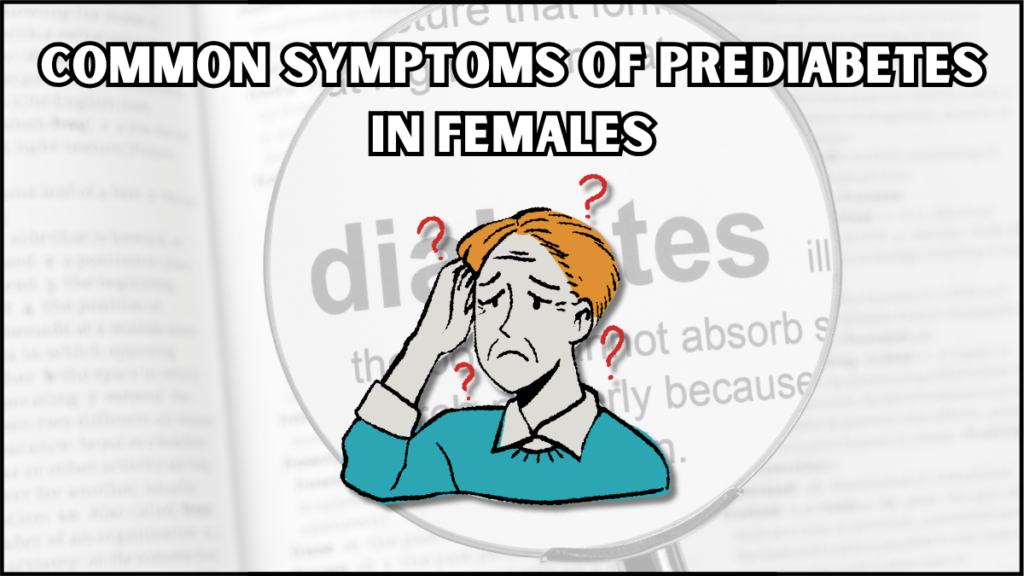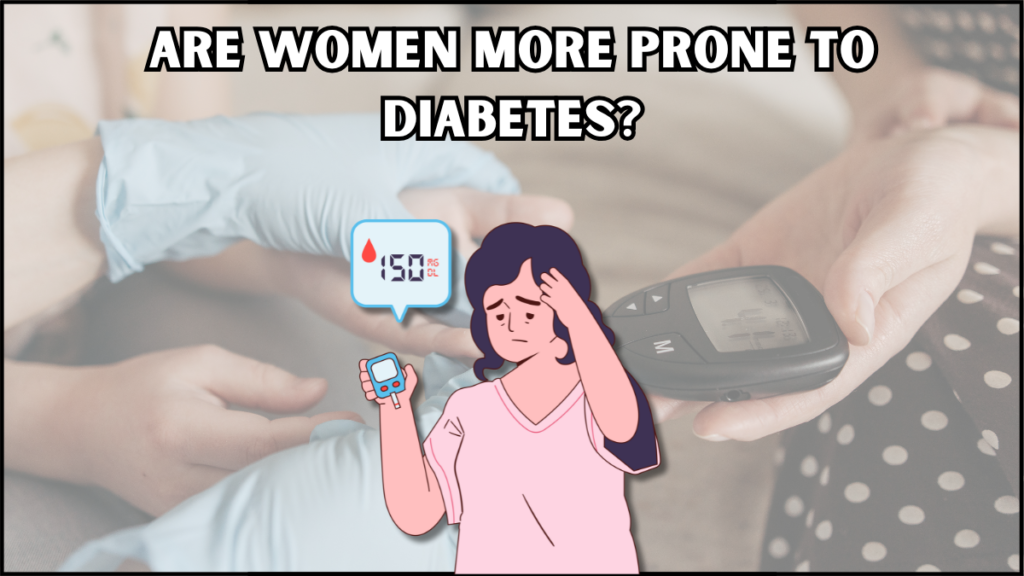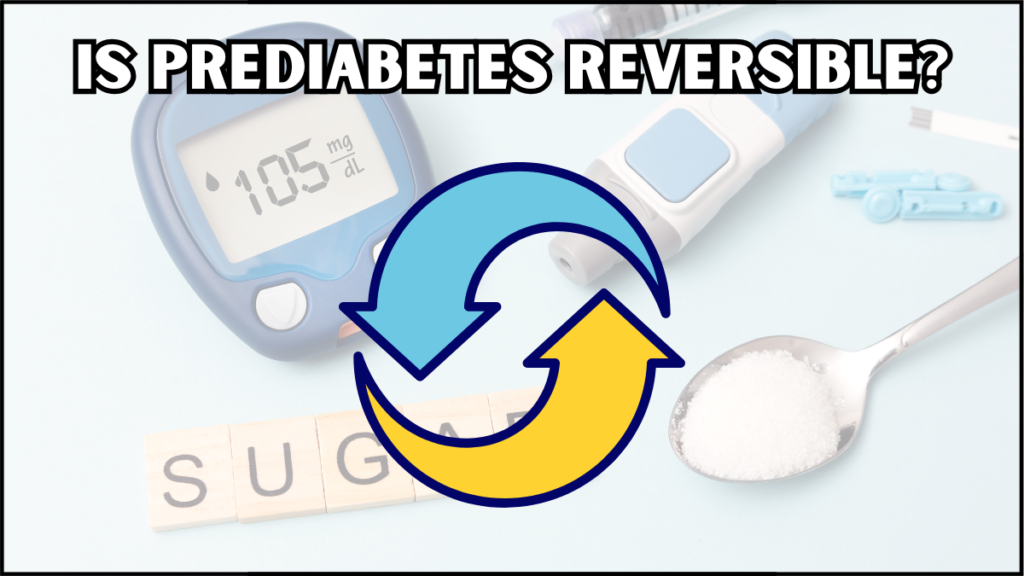Is Your Body Trying to Warn You About Prediabetes? Here’s How to Tell!
Have you been feeling more tired than usual? Noticing stubborn weight gain, increased thirst, or unexplained cravings? You might think it’s just stress, hormones, or aging but these could actually be early signs of prediabetes.
Prediabetes is your body’s way of sounding the alarm before full-blown type 2 diabetes develops. The problem? Most women don’t recognize the warning signs until it’s too late.
But here’s the good news: Prediabetes is 100% reversible if caught early!
This guide will walk you through:
✅ The most common symptoms of prediabetes in females
✅ Why these symptoms happen and what they mean
✅ How to reverse prediabetes permanently with simple lifestyle changes
Your health is in your hands, and small changes today can prevent serious health problems in the future. Let’s dive in and take control of your blood sugar before it controls you! 💙
Table of Contents
What Is Prediabetes?
Prediabetes is a warning stage before type 2 diabetes. It happens when blood sugar levels are higher than normal but not high enough to be classified as full-blown diabetes.
Think of it as a yellow traffic light your body is telling you to slow down and make changes before you reach the “red light” of type 2 diabetes. The biggest problem? Most women with prediabetes don’t even know they have it! Because they don’t have any idea of the signs of prediabetes in women.
Many women only find out when they get tested by a doctor or when symptoms become more noticeable. That’s why understanding the signs of prediabetes in women is crucial.
To know more about prediabetes, read here: Prediabetes: What You Need to Know and How to Reverse It Naturally?
Common Symptoms of Prediabetes in Females
Prediabetes often develops silently, meaning many women don’t realize they have it until it progresses into type 2 diabetes.
Unlike some health conditions that have clear and obvious symptoms, prediabetes can show up in subtle ways small changes in how you feel, look, or function that might seem normal or unrelated.
Many women mistake these early signs for everyday fatigue, aging, or stress, but ignoring them can be risky. Recognizing these symptoms of prediabetes in females early gives you a chance to take control and learn how to reverse prediabetes permanently before it turns into diabetes.
Below are the most common signs of prediabetes in females, why they happen, and what you can do about them.
If you notice two or more of these symptoms, it’s a good idea to talk to your doctor and check your blood sugar levels.

1. Increased Fatigue – Always Feeling Tired
Do you often feel exhausted even after a full night’s sleep?
🔹 Why It Happens:
- In prediabetes, your body struggles to use glucose (sugar) for energy efficiently.
- This happens because your cells become resistant to insulin, the hormone that helps move sugar from your blood into your cells.
- As a result, your cells don’t get enough energy, making you feel constantly drained.
🔹 How It Feels:
- You wake up tired even after 8 hours of sleep.
- You feel sluggish in the afternoon, no matter how much coffee you drink.
- Everyday activities feel more exhausting than usual.
✅ What to Do: Eating balanced meals with protein, fiber, and healthy fats can help stabilize blood sugar and reduce fatigue.
2. Frequent Urination – Going to the Bathroom More Often
Have you noticed that you urinate more often, even at night?
🔹 Why It Happens:
- When blood sugar levels are high, your kidneys work overtime to remove excess sugar from your blood.
- To do this, your body produces more urine, leading to frequent trips to the bathroom.
🔹 How It Feels:
- You feel the need to urinate even when you haven’t had much to drink.
- You wake up multiple times during the night to go to the bathroom.
- You feel slightly dehydrated despite drinking a normal amount of fluids.
✅ What to Do: If you’re experiencing frequent urination along with increased thirst, it’s a sign you should get your blood sugar checked.
3. Increased Thirst – Always Feeling Dehydrated
Are you drinking more water than usual but still feeling parched?
🔹 Why It Happens:
- Since frequent urination causes fluid loss, your body tries to make up for it by making you feel thirsty.
- No matter how much water you drink, the cycle continues until blood sugar levels return to normal.
🔹 How It Feels:
- You constantly feel thirsty, even after drinking plenty of water.
- Your mouth feels dry, and you may experience chapped lips more often.
✅ What to Do: Avoid sugary drinks, which can make the problem worse. Stick to plain water or herbal tea.
4. Unexplained Weight Gain or Trouble Losing Weight
Have you been gaining weight even though your diet hasn’t changed?
🔹 Why It Happens:
- Insulin resistance causes your body to store more fat, especially around the belly.
- High insulin levels make it harder for your body to break down fat.
- You may experience strong sugar cravings, leading to overeating and weight gain.
🔹 How It Feels:
- You’re gaining weight despite eating the same as before.
- It’s harder to lose weight even when you exercise.
- You feel like your appetite is out of control, especially for carbs.
✅ What to Do: Focus on protein, fiber, and healthy fats to reduce insulin spikes and make weight loss easier.
5. Dark Patches on the Skin (Acanthosis Nigricans)
Have you noticed dark, velvety patches on your neck, underarms, or other body folds?
🔹 Why It Happens:
- This skin condition, called Acanthosis Nigricans, is a sign of insulin resistance.
- When insulin levels are too high, skin cells multiply faster, causing dark, thickened skin in certain areas.
🔹 Where It Appears:
- Neck
- Armpits
- Groin
- Under the breasts
✅ What to Do: Losing weight and lowering insulin levels through a healthy diet and exercise can help lighten these patches.
6. Frequent Sugar Cravings – Always Wanting Something Sweet
Do you constantly crave sweets, even after eating?
🔹 Why It Happens:
- Your body is having trouble processing sugar properly.
- When blood sugar drops, your brain signals you to eat more sugar to bring it back up.
- This causes a vicious cycle of sugar cravings and energy crashes.
🔹 How It Feels:
- You always feel the urge to snack on sweets or carbs.
- You feel a sudden energy spike after eating sugar, followed by a crash.
- You feel shaky, dizzy, or irritable if you don’t eat something sugary.
✅ What to Do: Swap processed sugar for natural alternatives like fruits, nuts, and high-protein snacks.
7. Slow Healing Wounds
Do small cuts and bruises take longer to heal than before?
🔹 Why It Happens:
- High blood sugar damages blood vessels, slowing down the healing process.
- Your immune system becomes weaker, making it harder for your body to fight infections.
🔹 How It Feels:
- Minor cuts and bruises seem to take weeks to heal.
- You get frequent infections like yeast infections or UTIs.
✅ What to Do: Managing blood sugar can improve wound healing over time.
8. Hormonal Imbalance & Irregular Periods
Is your period unpredictable or different from usual?
🔹 Why It Happens:
- Insulin resistance affects hormone production, disrupting menstrual cycles.
- Many women with prediabetes also have PCOS (Polycystic Ovary Syndrome), a condition linked to insulin resistance.
🔹 How It Feels:
- Your periods are irregular or missing.
- You experience severe PMS, mood swings, or acne.
- You have symptoms of PCOS like excessive hair growth or weight gain.
✅ What to Do: A low-glycemic diet and regular exercise can help balance hormones.
9. Tingling or Numbness in Hands and Feet
Do your hands or feet sometimes feel numb or tingly?
🔹 Why It Happens:
- High blood sugar damages nerves, leading to tingling, numbness, or burning sensations.
- This condition is known as diabetic neuropathy, and it usually starts in the hands and feet.
🔹 How It Feels:
- A pins-and-needles sensation in your hands, feet, or fingers.
- A feeling of numbness or weakness in certain areas.
- Symptoms come and go but may worsen over time.
✅ What to Do: Keeping blood sugar under control can prevent further nerve damage.
Recognizing these signs of prediabetes in women early can help you take action before it turns into diabetes. If you’ve noticed two or more of these symptoms, it may be time to get your blood sugar checked.
💬 These are some of the common symptoms of prediabetes in females. Have you experienced any of these symptoms? Share your thoughts in the comments below! 💙
Are Women More Prone to Diabetes?
Did you know that women face unique challenges when it comes to diabetes?
While men and women are equally at risk, factors like hormonal changes, pregnancy, and conditions like PCOS can make it harder for women to regulate blood sugar. Identifying the symptoms of Prediabetes in females plays a major role.
Even more concerning, women with diabetes are at a higher risk of heart disease and complications than men. But here’s the good news understanding these risks means you can take action!
Whether you’ve experienced gestational diabetes, PCOS, or are going through menopause, knowing how these factors affect blood sugar can help you stay ahead of prediabetes and prevent type 2 diabetes before it starts.
Let’s dive into why women need to be extra mindful and how to take control of your health starting today!

Why Are Women at Higher Risk?
1. Hormonal Changes & Insulin Resistance
Hormones like estrogen and progesterone affect how the body uses insulin. During menopause and pregnancy, these hormonal shifts can make blood sugar harder to control, increasing the risk of prediabetes.
2. PCOS (Polycystic Ovary Syndrome)
Women with PCOS often have insulin resistance, which means their bodies struggle to use insulin properly. This makes them 4-5 times more likely to develop type 2 diabetes.
3. Gestational Diabetes
Some women develop high blood sugar during pregnancy (gestational diabetes). Even if blood sugar returns to normal after delivery, these women have a higher risk of prediabetes and type 2 diabetes later in life.
4. Higher Risk of Heart Disease
Women with diabetes face a higher risk of heart disease and stroke than men with diabetes. Since heart disease is already the #1 killer of women, managing blood sugar is even more critical.
How Women Can Stay Ahead of Prediabetes?
If you’re a woman with PCOS, a history of gestational diabetes, or nearing menopause, here’s how to lower your risk:
✅ Get Regular Checkups – Ask your doctor for an A1C or fasting blood sugar test if you have risk factors.
✅ Manage Hormonal Changes – A healthy diet and exercise can help keep insulin resistance under control.
✅ Maintain a Healthy Weight – Losing even 5-10% of your body weight can greatly reduce your risk.
✅ Eat for Blood Sugar Balance – Focus on fiber, protein, and healthy fats while cutting out processed carbs and sugary drinks.
✅ Stay Active – 30 minutes of exercise (like walking, yoga, or strength training) 5 days a week can improve insulin sensitivity.
✅ Prioritize Heart Health – Keep an eye on blood pressure, cholesterol, and stress levels to lower your heart disease risk.
While women face unique risks, that doesn’t mean diabetes is inevitable! By staying informed, making small but powerful lifestyle changes, and getting regular checkups, you can stay ahead of prediabetes and take control of your health.
💡 Remember: Your health is in your hands! Whether it’s managing hormones, eating for blood sugar balance, or staying active, every small step you take reduces your risk of diabetes and keeps you feeling your best.
Also keep in mind the symptoms of prediabetes in females and you can reverse prediabetes with the help of our next section: “How to reverse Prediabetes permanently?”
🚀 Now it’s your turn! Have you faced any of these challenges? Share your thoughts or questions in the comments below, and let’s support each other on this journey to better health! 💙
Is Prediabetes Reversible?
Yes! Prediabetes is reversible, but it requires consistent lifestyle changes.
By adopting a healthy diet, staying physically active, managing stress levels, and improving sleep quality, you can restore insulin sensitivity and bring blood sugar back to normal.
Even losing just 5-10% of your body weight can make a huge difference. Many people see improvements within a few months, but staying committed is key.
The sooner you take action, the higher your chances of preventing type 2 diabetes and living a healthier, more energetic life.
Prediabetes is your second chance use it wisely! 💙 Read more in detail about reversing Prediabetes here: Prediabetes: What You Need to Know and How to Reverse It Naturally?

How to Reverse Prediabetes Permanently?
Now that we know prediabetes in females is reversible, let’s learn how to reverse prediabetes permanently:
1. Adopt a Healthy Diet
- Eat fiber-rich foods like vegetables, whole grains, and beans.
- Cut down on processed foods, sugary drinks, and refined carbs (like white bread and pasta).
- Include healthy fats (avocados, nuts, olive oil) and lean proteins (chicken, fish, eggs).
📌 Tip: Try following a Mediterranean diet or low-carb diet to help balance blood sugar.
2. Exercise Regularly
- Aim for at least 30 minutes of movement 5 days a week.
- Walking, swimming, dancing, or strength training can help your body use insulin better.
📌 Tip: Even a 10-minute walk after meals can lower blood sugar levels!
3. Maintain a Healthy Weight
- Losing just 5-10% of your body weight can greatly reduce your risk of diabetes.
📌 Example: If you weigh 180 lbs, losing just 9-18 lbs can make a BIG difference.
4. Stay Hydrated
- Drinking enough water helps flush out excess sugar from your body.
📌 Tip: Avoid sugary drinks like soda, fruit juices, and energy drinks.
5. Manage Stress Levels
- Chronic stress raises blood sugar and makes insulin resistance worse.
- Try meditation, yoga, deep breathing exercises, or journaling to keep stress in check.
📌 Tip: Even 5 minutes of deep breathing a day can lower stress levels!
6. Get Enough Sleep
- Poor sleep can cause insulin resistance and make it harder to lose weight.
- Aim for 7-9 hours of quality sleep each night.
📌 Tip: Try turning off screens 30 minutes before bedtime to improve sleep.
7. Monitor Your Blood Sugar Levels
- If you have risk factors for diabetes, check your blood sugar levels regularly and consult your doctor.
📌 Tip: A simple A1C test can tell you if your blood sugar levels are in the prediabetic range.
8. Avoid Smoking and Limit Alcohol
- Smoking and excessive alcohol intake make insulin resistance worse.
- Cutting back can greatly improve your health.
📌 Tip: If you drink alcohol, stick to 1 drink per day for women.
Conclusion: Take Charge of Your Health Before It’s Too Late!
Prediabetes in females is the body’s early warning system, giving you the chance to take action before type 2 diabetes takes control of your life.
The symptoms like fatigue, weight gain, excessive thirst, dark skin patches, and sugar cravings may seem small, but they are big signs of prediabetes in women telling you that your blood sugar is out of balance.
The best part? Prediabetes is reversible! And by now you must have learnt how to reverse prediabetes permanently. By making small but powerful lifestyle changes eating better, moving more, managing stress, and getting quality sleep you can control the signs of prediabetes in women and bring your blood sugar back to normal and avoid diabetes altogether.
Don’t wait for more serious complications to show up. If you’re experiencing two or more of the above mentioned symptoms of prediabetes in females, it’s time to take action!
Talk to your doctor, get your blood sugar checked, and start making changes today. 💙 Your future self will thank you! Have you noticed any of these signs? Share your thoughts or experiences in the comments below! 🚀
Reference
This article “Prediabetes in Females” and the section “Common Symptoms of Prediabetes in Females” is based on general knowledge, medical research, and reputable health sources such as:
- American Diabetes Association (ADA) – diabetes.org
- Centers for Disease Control and Prevention (CDC) – cdc.gov/diabetes
- Harvard T.H. Chan School of Public Health – hsph.harvard.edu
- National Institute of Diabetes and Digestive and Kidney Diseases (NIDDK) – niddk.nih.gov
- Mayo Clinic – Prediabetes Diet Guidelines – mayoclinic.org
